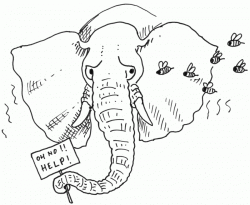Elephant can: They avoid the bees at all costs
Q. Do you kiss the right way? –J. Frost
A. No judgments are intended here as there's really no "wrong" way to do it. Rather, "right" pertains to the right or left tilt of the kissing head. Just as most people kick with their right foot, throw with their right arm, or look through a microscope with their right eye, most of us kiss with our head tilted right, said biopsychologist Onur Gunturkun in Nature magazine.
He observed 124 kissing couples age 13 to 70 in airports, railway stations, beaches, and parks in the U.S., Germany, and Turkey and found that two-thirds of the participants kiss this way. Even in Rodin's famous masterpiece "The Kiss," the lovers turn their heads to the right.
As Gunturkun summed up, this 2:1 kissing bias means that for every nine couples, four by chance would both have the right bias, ensuring a good initial lip-to-lip contact; one couple would have a left bias, again ensuring successful contact.
"However, statistics dictate that four couples would clash noses as they attempted a left/right kiss," he says cheekily.
Q. How do we say "@"? Is it the "at sign" or the "cat sign"? –N. Webster
A. It's the former, of course. We'll get to the cat in a moment. In 1971, American computer engineer Ray Tomlinson sent the world's first email and he needed a symbol to identify the location of the sender within the email system, says David Crystal in A Little Book of Language. He chose @, called the "at sign" in English today.
But some other languages give it other names, as people look at its odd shape and compare it to a worm, an elephant's trunk, a monkey's tail and so on. It's called a "malpa" in Poland (for "monkey" in Polish), a "sobaka" in Russia (Russian for "dog"), a "papaka" in Greece (Greek for "duckling").
"My favorite is one of the names it's received in Finland: 'miukumauku'– Finnish for 'miaow-meow,'" Crystal writes.
Q. True or False: The mammoth eight-ton African elephant stands as worry-free king of the beasts. –Dumbo
A. While it's true that East Africa's elephants face few threats (aside from humans and lions) in their savanna home, the behemoths are terrified of African bees, says Science magazine. And with good reason: An angry swarm can sting elephants around their eyes and inside their trunks and pierce the skin of young calves that have yet to develop a thick protective hide. Now a new study has shown that these pachyderms utter a distinctive rumble in response to the sound of bees, the first time that an alarm call to the group has been identified. So skittish are elephants that fences made of beehives wired together can significantly reduce crop raids. Actually, all it takes is a recording of the bees to have the deterrent effect.
Q. Is it all right to be left-handed? –D. Perkins
A. Judging by everyday conversation, left-handedness is not all right, says David G. Myers in Psychology. To be "coming out of left field" is hardly better than to be "gauche" (from the French word for "left"); on the other hand, right-handedness is "right on," which any righteous right-hand man in his right mind rightly is.
Left-handers turn out to be especially numerous among those with reading disabilities, allergies, and migraine headaches. But in Iran, where students taking university entrance exams report which hand they write with, lefties outperform righties in all subjects. Lefties are also more common among musicians, mathematicians, professional baseball and cricket players, architects and artists (Michelangelo, Leonardo da Vinci and Picasso).
"Although left-handers must tolerate elbow jostling at the dinner table, right-handed desks, and awkward scissors,” Myers writes, “the pros and cons of being a lefty seem roughly equal."
~
Send Strange questions to brothers Bill and Rich at [email protected]
